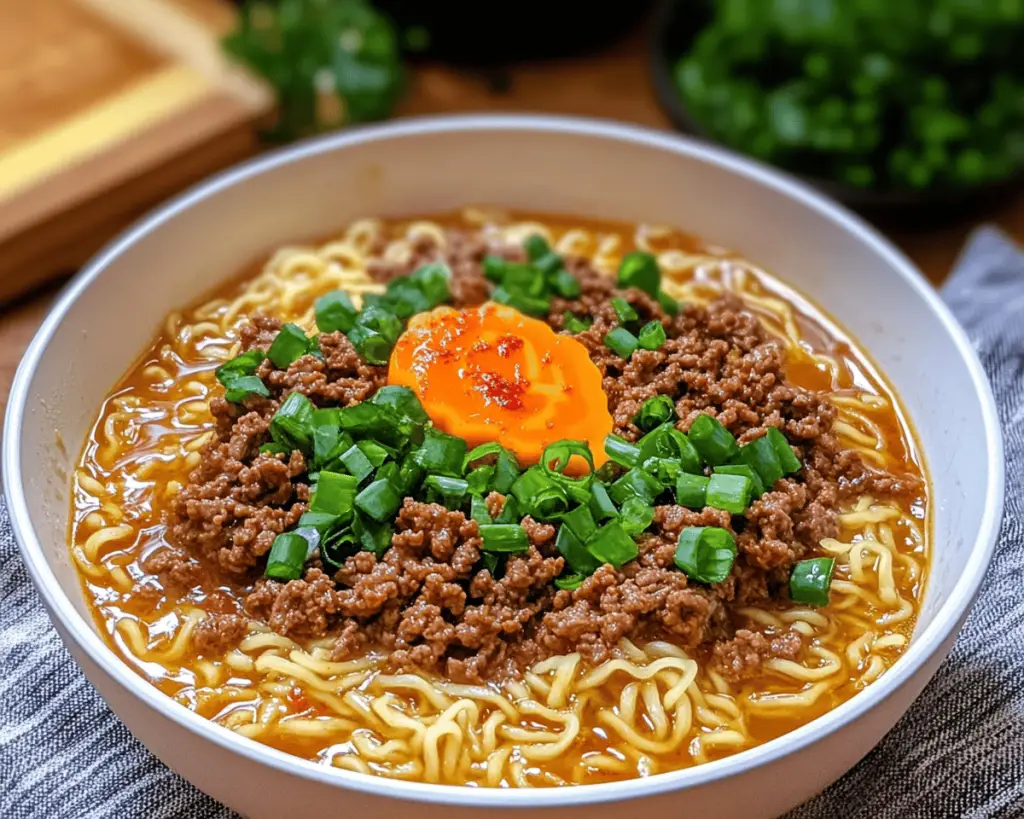I don’t know about you, but there’s something incredibly comforting about a warm bowl of ramen. And we’re not just talking about the instant kind that might have made up my college diet (although I still love those little packets, no judgment!). No, what I’m going to share today is a Korean-Style Ground Beef Ramen that digs deep into my soul and fills my belly with undeniable joy.
This recipe takes me back to chilly evenings when I’d come home after a long day and just wanted to cozy up with something warm, fulfilling, and a little spicy. It was one of those happy accidents that turned into a regular staple—like the time I had ground beef in the fridge and decided to get a bit adventurous with my usual ramen. You know what I mean? Sometimes cooking is like playing jazz—improvisation can lead to the best creations! A bit of this, a sprinkle of that, and before I knew it, I’d crafted a dish that had everyone coming back for seconds—or thirds.
I remember the first time I made this without even having a proper recipe. I had some leftovers from the previous night’s bulgogi, and I was feeling experimental, so I thought, “Why not throw this in with some ramen?” Let’s just say, the combination of flavors hit me like a wave of nostalgia and comfort. I found myself leaning over the pot with a giant spoon, unable to resist tasting every few minutes. The savory beef, crunch from veggies, and silky broth flowed together into heavenly deliciousness. From that day on, it became a dish that I whip up whenever I want a taste of home.
Now, every time I conjure this Korean-Style Ground Beef Ramen, I can’t help but get excited about the flavors and sensations that come alive in that bowl. So, let’s dive into what makes this dish special and how you can bring a little bit of that cozy vibe into your kitchen.
What Goes Into Korean-Style Ground Beef Ramen?
So let’s break down the magic ingredients that come together in this recipe. Each one has a purpose and a little backstory.
1. **Ground Beef** – This is the star of the show! I usually go for **80/20 ground beef** because fat equals flavor, am I right? Just a touch of grease makes all the difference. I always remember my first apartment where I learned the art of browning ground beef just right. It’s all about patience; don’t rush it! Let it deliciously caramelize before you go adding anything else.
2. **Soy Sauce** – A splash of this liquid gold brings umami to the table. I’m a firm believer in using **low-sodium soy sauce** because the flavor can be intense, and you want to keep things balanced. My best friend got me hooked on this brand that her mom always uses—something about the ingredient quality just elevates the dish!
3. **Gochujang** – Ah, the spicy-sweet Korean chili paste. If you haven’t discovered this yet, you’re in for a treat! It adds depth and a subtle heat that’s hard to replicate. I could eat it straight from the jar (okay, maybe I have). A couple of tablespoons stirred into the ground beef are a game-changer and makes anyone who tries it think I’m a culinary genius.
4. **Garlic** – Are we really cooking if there’s no garlic? I think not! I love using fresh minced garlic—there’s just nothing like that fragrant aroma filling your kitchen. Chop it up nice and fine; that pungent goodness is what your ramen deserves.
5. **Green Onions** – These delightful garnishes are like little green fairy wands scattered on top of the dish at the end. They add a fresh bite that’s crucial for balancing out the richness of the beef. I like to use both the greens and the whites. When I was a kid, my mom always had green onions growing in a small pot on the kitchen windowsill. It was a magical little herb garden, and I feel the same thrill every time I chop into them.
6. **Ramen Noodles** – I mean, duh, right? Use either **instant ramen noodles** or the fresh kind if you can find them. Honestly, whatever I can get my hands on works! I do have a secret stash of my favorite noodles from a local Asian grocery store, but in a pinch, the instant ones suit me just fine.
7. **Vegetables** – Here’s the fun part! I usually toss in whatever I have lying around—carrots, bok choy, bell peppers, or even some frozen peas if I’m in a particularly lazy mood. The key is to have a mix of colors that bring life to the bowl, and keep them fresh and crunchy. My cousin tends to overcook her veggies. A sprinkle of salt and crunch is what brings this dish to life, not mush!
8. **Eggs** – Not just a protein boost; they also add a lovely creaminess when you swirl the yolk into the hot broth. Soft-boiling them is my favorite way, and I remember trying to master the perfect 6-minute egg for what felt like an eternity. Turns out it’s well worth the effort!
9. **Sesame Oil & Seeds** – Just a drizzle of this nutty oil ramps up the flavor profile to a whole new level. I’ve learned that a little goes a long way! And the sesame seeds? Well, they bring some crunch and flair when you sprinkle them on top. Plus, they remind me of my uncle’s epic noodle parties, where we’d compete over who could sprinkle the most without getting it everywhere. Spoiler alert: I lost.
Is Korean-Style Ground Beef Ramen Actually Good for You?
Okay, let’s talk real here. As much as I adore this dish, it doesn’t pretend to be health food. But who needs to be all serious about that when comfort food is on the table, right? I mean, it gives your heart—both literally and figuratively—a warm hug!
Of course, let’s not completely throw caution to the wind. **Lean ground beef** provides protein and iron, while the **vegetables** add a nice nutritional balance and fiber, which is always a win. When I load up my ramen with veggies, I can almost convince myself it’s health food—hey, it counts, right?
The **soy sauce** adds a bit of sodium, so if you’re watching your intake, use the low-sodium kind I mentioned before. The **gochujang** will give you that kick without going overboard on calories, adding flavor while still being fairly wholesome.
The most important thing for me though? The mental boost and comfort this ramen provides. Food is about connection, love, and memories. Indulgence can sometimes be a form of self-care, and I think we all need that from time to time.
Here’s What You’ll Need
– 1 lb **ground beef**
– 2 tbsp **soy sauce** (preferably low-sodium)
– 2 tbsp **gochujang**
– 4 cloves **garlic**, minced
– 4 cups of water or beef broth
– 2 packets **ramen noodles** (discard the seasoning packets)
– 1 cup mixed **vegetables** (carrots, bell peppers, bok choy, etc.)
– 2-4 **green onions**, chopped
– 2 **eggs** (soft boiled)
– 1 tsp **sesame oil**
– 1 tbsp **sesame seeds**, for garnish
This recipe should serve about 4 people if you feel like sharing. But let’s be real, you might want to keep it all to yourself—I wouldn’t blame you!
How to Make Korean-Style Ground Beef Ramen Step-by-Step
1. **Brown the Beef:**
In a large pot, heat over medium-high heat. Add the **ground beef**. Here’s the deal—don’t touch it for a couple of minutes; let it brown! Then start breaking it up into chunks. You want a nice caramelization before moving on. It’ll smell divine!
2. **Add the Garlic:**
Once the beef is browned, add in your minced **garlic**. There’s no such thing as too much garlic, in my book! Stir it around until fragrant—about 30 seconds to a minute.
3. **Mix in Sauces:**
Now, let’s get those flavors swimming! Add the **soy sauce** and **gochujang**. I always get a little excited when I see that vibrant red paste mix in with the beef. It’s like a culinary hug. Stir it all together and let it cook for a couple of minutes—trust me, you’ll want those flavors to shine.
4. **Add Liquid:**
Pour in your **water** or **beef broth**. Bring it to a simmer. Now’s the time to take a few deep breaths and admire your creation. I always take a moment to appreciate how pretty the colors are.
5. **Cook the Noodles:**
Toss in your **ramen noodles**. Cook according to the package instructions. If you’re using fresh noodles, they’ll typically be ready much faster—so keep an eye on them! A timer is your best friend.
6. **Add Vegetables:**
Just about a minute before the noodles are done, toss in your **mixed vegetables**. I love the crunch of fresh veggies, and I usually prefer them to stay a bit undercooked for that perfect bite!
7. **Soft Boil the Eggs:**
While your ramen is cooking, you might want to soft-boil your eggs separately. Bring a small pot of water to a boil. Gently add your eggs and cook for about 6 minutes. Immediately transfer them to an ice bath to stop the cooking process. Once cooled, peel them and slice in half.
8. **Finish with Garnishes:**
When your ramen is ready, ladle it into bowls, top it with green onions, a drizzle of **sesame oil**, and a couple of halves of those perfectly cooked soft-boiled eggs. Then sprinkle on some **sesame seeds** for that extra crunch.
And there you have it! Your Korean-Style Ground Beef Ramen is ready to enjoy. Seriously, take a moment to inhale those comforting aromas before digging in.
Little Extras I’ve Learned Along the Way
So, now that you have the basics down, let’s talk about some fun little tweaks I love to play with.
– **Different Proteins:** If you wanna mix it up, ground turkey or chicken works well too! The flavor might change a bit, but you’ll still get that satisfying base in your bowl.
– **Rice Noodles:** Feeling particularly noodle-happy? Go for rice noodles instead! They are slightly different, but man, they soak up those flavors beautifully.
– **Spice It Up:** If you love heat, throw a bit of sliced jalapenos or red pepper flakes in with the veggies. I love a little burn in the back of my throat!
– **Make It Extra Creamy:** I’ve experimented with adding a splash of coconut milk for a more cream-like broth. Just a little bit—don’t overdo it! It creates a whole new layer that’s unexpectedly delightful.
– **Top It Off:** Sometimes, I’ll add a little nori or seaweed on top because why not? It makes it feel like I’m dining at a fancy restaurant, even if I’m still in my pajamas.
– **Vegan Version:** For my plant-based friends, you can use a combination of mushrooms and tofu to replace beef. Just sauté the mushrooms with garlic until they’re golden and then follow the same directions!
This is a dish that shines with endless creativity. I’ve learned to embrace the small imperfections and hiccups. Sometimes the beef doesn’t brown perfectly, or I forget to soft-boil the eggs. But you know what? It always turns into something delicious, and that feels like a win in the kitchen.
I can’t encourage you enough to give this recipe a go. This one means a lot to me. It’s a hug in a bowl, packed with love and flavor. Let me know if you try it—I’d love to hear your twist! Keep cooking with joy!



